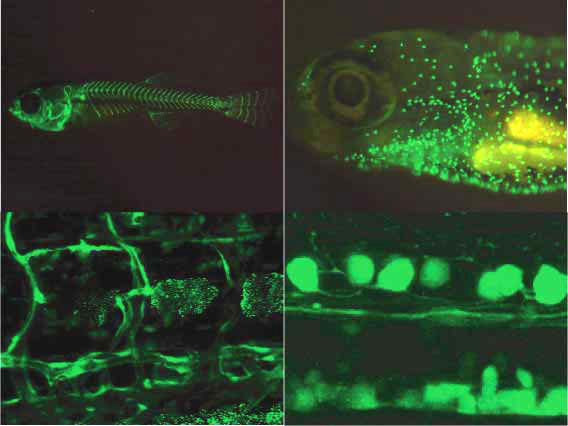Science News
Fishy Thoughts
March 1, 2013

By Zuberoa Marcos
Ever wonder what fish think about?
For the first time, a group of scientists from Japan’s National Institute of Genetics have captured video of thoughts moving through the brain of a zebrafish (Danio rerio).
Zebrafish often serve as animal models in research because of their transparent bodies. By inserting a gene into the larvae—and using a probe that detects florescence, the scientists captured the fish’s mental reaction to a swimming paramecium (think “dinner”) in real time.
The key element to the technology is a special indicator called GCaMP that reacts to the presence of calcium ions by increasing florescence. Since neuron activity in the brain involves rapid increases in concentrations of calcium ions, insertion of GCaMP causes the particular areas that are activated in a zebrafish brain to glow brightly. By using a jellyfish protein called GFP sensitive to florescence and neuroimaging techniques such as fMRI, the scientists monitored the locations of the fish’s brain activated at any given moment and thus, capture the fish’s thought as it “swam” around the brain.
The results show that when the paramecium moved from right to left, the zebrafish’s neuron activity moved from left to right, because in our brains the signals from our eyes cross over into the opposite half of the brain. If the paramecium stayed still next to the fish’s eye, its brain never fired.
This isn’t the first time that GCaMP gene has been inserted into a zebrafish for imaging purposes, but no real-time video images had been captured before. The achievement, published in Current Biology, could have future applications in humans. Scientists could quickly map the parts of the brain affected by a chemical under consideration for potential drug or treatment uses, thus shortening the development of new and more effective psychiatric medications.
The new tool now makes it possible to ask which brain circuits are involved in complex behaviors, from perception to movement to decision-making, the researchers say, noting that the basic design and function of a zebrafish brain resembles our own.
“In the future, we can interpret an animal’s behavior, including learning and memory, fear, joy, or anger, based on the activity of particular combinations of neurons,” study author Koichi Kawakami says.
Zuberoa Marcos is a former biologist and current science writer based in Barcelona. She writes articles regularly for Science Today.
Lo que piensan los peces
Por Zuberoa Marcos
Por primera vez, un grupo de científicos del Instituto Nacional de Genética en Japón ha capturado un vídeo de los pensamientos de un pez cebra (Danio rerio) moviéndose en el interior de su cerebro.
El pez cebra es un modelo animal muy utilizado en investigación porque su cuerpo es transparente. Insertando un gen en el pez cebra y utilizando una molécula que detecta la fluorescencia, los científicos fueron capaces de capturar, en tiempo real, la reacción mental del pez a un paramecio nadando en su entorno.
El elemento clave de la tecnología japonesa es un gen llamado GCaMP que reacciona ante la presencia de iones de calcio provocando un aumento en la fluorescencia. La actividad neuronal en el cerebro implica un rápido incremento en las concentraciones de iones de calcio, por lo que la inserción del gen hace que determinadas áreas del cerebro del pez cebra se activen y brillen. Utilizando una proteína de las medusas llamada GFP sensible a la fluorescencia y técnicas de neuroimagen como la FMRI, los investigadores fueron capaces de monitorizar las áreas del cerebro de los peces que se activaron en cada momento y, por lo tanto, capturar cómo se movía su pensamiento de unas regiones a otras.
En concreto, los investigadores analizaron qué sucede cuando un pez cebra ve un paramecio -un organismo unicelular que el pez considera una fuente de alimento- nadando ante si. Los resultados mostraron que cuando el paramecio se desplaza de derecha a izquierda, la actividad de la neuronas del pez lo hace de izquierda a derecha debido a que, en nuestro cerebr, las señales procedentes de los ojos se cruzan a la mitad opuesta del cerebro. Si el paramecio permanecía quieto, no había respuesta en el cerebro de animal.
Los científicos ya habían insertado con anterioridad el gen GCaMP en un pez cebra pero ésta es la primera vez que filman las imágenes de lo que sucede en el animal en tiempo real. El avance, publicado en la revista Current Biology, es impresionante en sí mismo pero, además, podría tener aplicaciones futuras en los seres humanos. Podría ayudar a identificar rápidamente las regiones del cerebro sobre las que actúa un potencial medicamento y hacer más breve el proceso de desarrollo de mejores fármacos para enfermedades psiquiátricas.
El trabajo también podría tener usos éticamente discutibles, como leer la mente. El equipo japonés está investigando cómo utilizar su proteína fluorescente en otras regiones del cerebro, para poder identificar los circuitos neuronales que intervienen en la toma de decisiones y en el forjado de distintos comportamientos. Creen que, con el tiempo, serán capaces de visualizar todo el cerebro a la vez incluso emociones como el miedo, la alegría o la ira en función de la actividad de combinaciones particulares de neuronas.
Zuberoa Marcos es bióloga retirada y actualmente trabaja como periodista científica desde Barcelona. Escribe de forma regular para Science Today.
Image: KAWAKAMI et al.